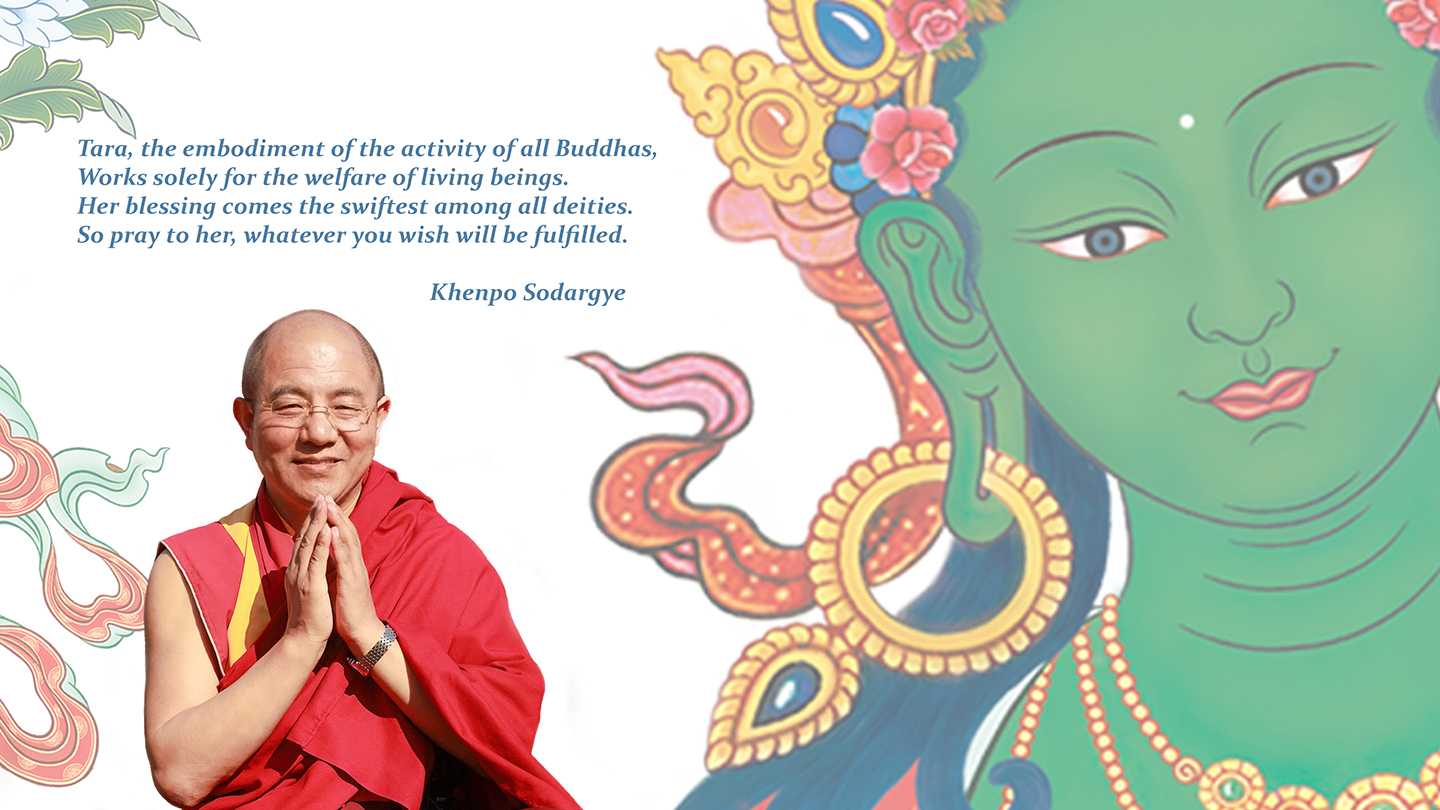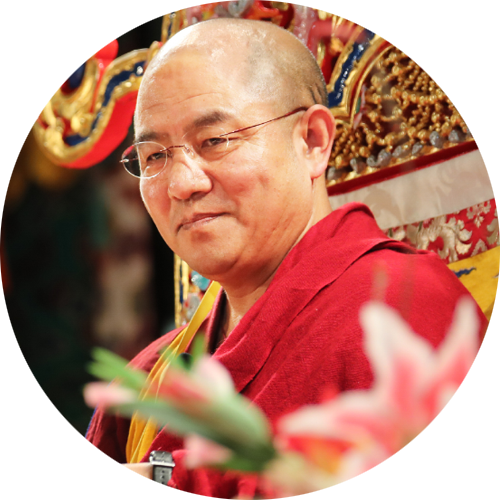Praises to the Twenty-One Taras
Many people now desire to be happy, wealthy, wise, safe and healthy. When we rely on Tara and pray to her sincerely and wholeheartedly, because of her blessing, all our wishes will quickly be accomplished, except for those with severely negative karma. People nowadays seem to live a good life, enjoying fine clothing and food, but many are suffering. The source of their suffering isn’t the lack of materials, but inner inadequacy. Many people are anguished by negative emotions like fear, worry, sadness, disappointment, or feeling of injustice. Why is there a growing number of people choosing to end their life? It is the incompleteness within, the lack of inner strength which makes people perceive everything in life in a negative way, as the cause of pain. Therefore, in times like these, if we can make prayers to and rely on Tara, because of her enlightened activities, she will respond very fast and all our fears and uneasiness will be dispelled instantaneously.

Please note that these pictures of the 21 Taras are only allowed for non-commercial use.
Lecture 1
In our daily life or throughout the course of Dharma learning and practice, we should pray to Tara, just as many previous masters did, so that adversities may be dispelled naturally. Take myself for example. When I was about to become ordained as a monk, I faced many challenges. Back then, it seemed to me that I was unable to fight back against them. I tried my best to pray to Tara and magically, all of the obstacles facing me disappeared. At that time, I was studying at Garze Normal School, and the head teacher of the class thought highly of me and gave me a great deal of attention. When I decided to become a monk, I had not graduated yet, and so I needed to ask the permission of my head teacher to leave school. If I failed to get his approval, my family would have been fined 3,000 RMB which was a huge sum of money at that time and which my family wouldn’t have been able to afford. So, I had no choice but to go to my teacher to ask for his permission. Before entering his house, I secretly did many recitations of the mantra of Tara and things turned out so smoothly that the teacher approved my request without hesitation. A while ago, this teacher came to visit me and I asked him, “I was sure that you were not going to agree to let me quit school as at the time you didn’t want me to become a monk. What made you change your mind?” He said, “I don t know why I agreed to allow you to quit school. I must have got into a muddle at that time.” So, I personally feel that the blessing of Tara is extremely genuine and responsive.
Lecture 2
Now, as we are learning the qualities of Tara, it is my hope that everyone can be joyful and generate great devotion to her. In particular, these days there are many female Buddhists and I think that Tara, as a female deity will probably take special care of you. So, for this reason, females in particular should pray to Tara. In this world, females inevitably encounter more unfavorable conditions and karmic obstacles than men. This is also mentioned by the Buddha in sutras; it’s not a prejudice against women. Thus, if female practitioners pray devotedly to Tara, many unfavorable conditions can be removed completely. Of course, male practitioners should also pray to Tara and will certainly receive swift and immense blessing, as well. Hopefully, all of you will cherish this opportunity to diligently learn and practice Tara.
Lecture 3
I often wonder, why in this age, the Buddhadharma could still be preserved so well in the Tibetan region? In this age of globalization, material things such as food and necessities are not in shortage. What do people lack the most now? Spiritual sustenance. Buddhadharma, as a mental remedy, is indeed the most needed for mankind. As you can see, many people with high level of education are interested in the Tibetan culture and yearn to visit the Tibetan area. There must be some reasons. What are they attracted to? Some people say they are attracted by the blue sky, the white clouds, and the vast green grassland in the Tibetan region. But these natural sceneries are not peculiar to the Tibetan region, as they can also be seen elsewhere.
As a matter of fact, the attraction of Tibet is rooted in the spirit of Buddhism, especially the essence of the altruistic Bodhichitta that has been well preserved through generations. As long as such spirit of Buddhism is preserved in the Tibetan plateau, people there will continue to be simple and pure, without much greed, hatred and ignorance in their mind, enjoying the atmosphere of inclusivity, freedom, and equality. But once the essence of Buddhadharma disappears in the Tibetan region, Tibetans would become as restless as people in big cities. Because whether Tibetans, Han people, or people elsewhere, in appearance, most are ordinary beings. For ordinary humans, they are easily caught up in the waves of greed, aversion, and ignorance, constantly experiencing suffering. So if without the nurture of Buddhadharma, Tibetans will also suffer from spiritual and physical deprivations.
Lecture 4
If one wishes to dispel all the unfavorable conditions and receive favorable supports, one can certainly rely on Tara, and in particular this prayer, the blessing of which can undoubtedly bring forth many accomplishments. Many great Tibetan masters, although they never declared it openly, did include Tara in their practice of the Three Roots, the most essential practice that every Vajrayana practitioner need, so Tara was one of their main practices. They regard Padmasambhava as their guru, Avalokiteshvara or Manjushri as their yidam, and Tara as their dakini.
Some female practitioners may wonder whether it is appropriate for female practitioners to take Tara as their dakini? Indeed, the so-called dakini is often misinterpreted. When practicing completion and generation stages, the visualization remains the same regardless of male or female practitioners. A female practitioner should also have her own Three Roots. She can take one female Buddha such as Sarasvati, Tara, or Ekajati as her dakini, Padmasambhava as her root guru, and have a yidam which her root guru chooses for her or whichever she has confident faith in. In our course of practice, if we wish for blessings, we’d rely on our guru; if we wish for spiritual accomplishment, we’d rely on our yidam; if we wish to swiftly fulfill our activities, we’d rely on our dakini, whose blessing and power are immense. In particular, for many practitioners, the Tara practice should be included in their practice of the Three Roots, because Tara can bestow the most reliable and the swiftest blessing. Moreover, her blessing is particularly fierce.
Lecture 5
Nowadays many people love to buy and wear amulets. Actually, the image of Tara is the best protection of all. Last year, I had some small Tara cards made and gave them to students here at Larung. If you carry it with you all the time, or keep it in the car or the house, it will benefit you immensely. In some practices, we visualize protective spheres to prevent negative influences. As a matter of fact, if you keep an image of Tara, then under Tara’s protective spheres or through her flaming vajras, all the external obstacles and disasters can be destroyed. She is able to save us from all kinds of danger. We often say that Tara can protect us from eight great fears such as the fear of fire, water, snakes, poisons, etc. All these disasters can be eliminated by the power of Tara.
In particular, some people often suffer involuntarily from the demonic influences. Although they don’t seem to encounter any major negativities externally, their minds are very much afflicted, full of obstructing emotions. Praying to Tara can help to overcome such obstacles as well. The reason that some people’s practice goes incredibly smoothly and successfully is that they have protection from within, from their deities. Tara is such a deity who can bestow protection upon you.
Lecture 6
Now, we have finished the course of the Praises to the Twenty-One Taras and many signs have pointed to the fact that our teaching and your learning of the Tara practice have been very promising. When H. H. Jigme Phuntsok Rinpoche was still with us, all of us recited the Tara mantra 700,000 times. I will not request that you recite it that many times, but I hope that everyone who attends this teaching can complete the Tara mantra at least 10,000 times and Praises to the Twenty-One Taras at least 100 times within a year. l will also commit to doing this as this will not be too much for any of us to complete. If we recite the Praises to the Twenty-One Taras just once during our Dharma class every day, at this rate, the accumulation of 100 recitals will be finished in only 3 months. Whether we recite the Praise together in class or you complete the practice individually after class, our one-year collective practice will enable all participants to make an auspicious connection with Tara. I hope that all of you can join this collective practice as I will surely join you.
Praises to the Twenty-One Taras with English Simultaneous Translation

